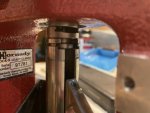I bought a 10 pack of the LNL bushings and the press insert. My main disappointment with them is that they don't lock on the die. They die must be torqued into the LNL bushing -- by how much? If it is torqued "finger-tight", that is insecure and can easily vary from time to time and with changes in temperature. If it's torqued more than finger-tight, the pressure on the die threads opposes those of the lock ring -- like a pair of jam nuts. If the die will never need to be adjusted, it can just be set, jammed, and forgotten -- it will keep the setting. On the other hand, if the die is adjusted frequently (bumping brass for different rifles, seating different bullets, crimping different length cases, or whatever), the LNL bushing is difficult to untorque. Attempting to untorque it in the press can result in the bushing insert unthreading. Instead, I would put it in the soft jaws of my vice and loosen the die. Only then could the lock ring be adjusted. I wouldn't put up with this for very long, and I doubt other people do. I suspect LNL users simply use "finger tightness." I prefer a die bushing that pinches the die with a cross-bolt. Finger-tight and o-ring friction don't seem very consistent.
To be fair, I can't account for a problem in the results -- but then we rarely select reloading equipment merely for the results. Lee presses can deliver excellent results, so why do people pay for Forster, Redding, and Dillon? It's not just because they measured the ammo produced with Lee and found a problem. Instead, they might have found the process of reloading with Lee was frustrating -- or maybe not, I've had good times with some Lee equipment.
I did not have a good time with Lock N Load Bushings. If they pinched the die with a cross-bolt thereby eliminating the need for a separate lock-ring with opposing torque, then I would enjoy them a lot more.
With respect to concentricity, it may not be the press or bushing that is introducing it. Furthermore, even inexpensive dies can be reamed with high-precision to produce excellent concentricity. Precision reamers are not a technological hurdle that require a high-end die company to overcome. Precision in bullet seating depth might be down to die quality, but probably not concentricity, either for sizing or seating.
A chamber with poor concentricity could be causing problems, but like dies, chambers machined with modern reamers are not likely to have this problem -- not likely, but possible. Brass can be marked and "clocked" as it's chambered and measured before and after firing to gauge whether the chamber is skewing it.
It's not likely the press either. Shell holders are loose-fitting. They're not like lathe collets where we can assure precision centering. In fact, Forster and MEC presses deliberately float the shell. So concentricity problems are not likely the fault of the press. So what is?
Brass. It's just not nearly as high-precision as the precision-machined steel parts in our tooling. If you have a concentricity checker, sort brass and see if it changes over time or the concentric brass stays concentric and the skewed brass stays skewed.

